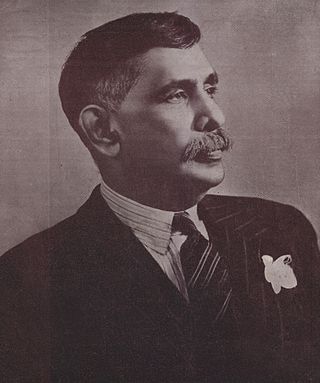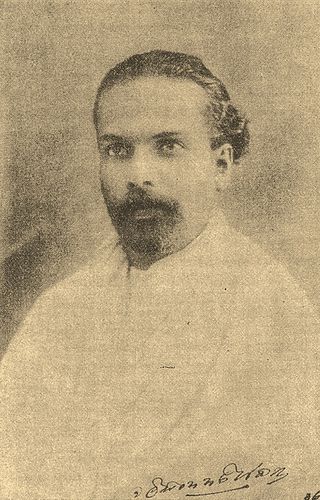Related Research Articles

Don Stephen Senanayake was a Ceylonese statesman. He was the first Prime Minister of Ceylon having emerged as the leader of the Sri Lankan independence movement that led to the establishment of self-rule in Ceylon. He is considered as the "Father of the Nation".

Theravada Buddhism is the largest and official religion of Sri Lanka, practiced by 70.2% of the population as of 2012. Practitioners of Sri Lankan Buddhism can be found amongst the majority Sinhalese population as well as among the minority ethnic groups. Sri Lankan Buddhists share many similarities with Southeast Asian Buddhists, specifically Myanmar Buddhists and Thai Buddhists due to traditional and cultural exchange. Sri Lanka is one of five nations with a Theravada Buddhist majority.

The Sri Lankan independence movement was a peaceful political movement which was aimed at achieving independence and self-rule for the country of Sri Lanka, then British Ceylon, from the British Empire. The switch of powers was generally known as peaceful transfer of power from the British administration to Ceylon representatives, a phrase that implies considerable continuity with a colonial era that lasted 400 years. It was initiated around the turn of the 20th century and led mostly by the educated middle class. It succeeded when, on 4 February 1948, Ceylon was granted independence as the Dominion of Ceylon. Dominion status within the British Commonwealth was retained for the next 24 years until 22 May 1972 when it became a republic and was renamed the Republic of Sri Lanka.
The Suriya-Mal Movement was formed in the British colony of Ceylon to sell Suriya flowers on Poppy Day for the benefit of Sri Lankan ex-servicemen. The movement became anti-imperialist in character, and was also involved in relief work during the Malaria epidemic of 1934–1935.

Dudley Shelton Senanayake, was a Sri Lankan statesman who served as Prime Minister of Ceylon from 1952 to 1953, in 1960, and from 1965 to 1970 and Leader of the Opposition from 1960 to 1964. Senanayake's tenures as prime minister were associated with democratic policies focused on agricultural and educational reforms with a pro-western alignment.

Dr. Cristopher William Wijekoon Kannangara was a Sri Lankan Lawyer and a politician. He rose up the ranks of Sri Lanka's movement for independence in the early part of the 20th century. As a lawyer he defended the detainees that were imprisoned during the Riots of 1915, many of whom were the emerging leaders of the independence movement. In 1931, he became the President of Ceylon National Congress, the forerunner to the United National Party. Later, he became the first Minister of Education in the State Council of Ceylon, and was instrumental in introducing extensive reforms to the country's education system that opened up education to children from all levels of society.
Fredrick Richard Senanayake was a Ceylonesen lawyer and independence activist. A leading member of the Sri Lankan independence movement, he was an elected member of the Colombo Municipal Council. F.R Senanayake, who would go on to lead Sri Lanka's independence movement, becoming a Barrister of independent Sri Lanka in 1947.
National Day, also known as Independence Day, is a Sri Lankan national holiday celebrated annually on 4 February to commemorate the country’s political independence from British rule in 1948. It is celebrated all over the country through a flag-hoisting ceremony, dances, parades and performances. Usually, the main celebration takes place in Colombo, where the President raises the national flag and delivers a nationally televised speech.

Edward Walter Perera was a Ceylonese barrister, politician and freedom fighter. He was known as the "Lion of Kotte" and was a prominent figure in the Sri Lankan independence movement, served as an elected member of the Legislative Council of Ceylon and the State Council of Ceylon.

National Hero is a status an individual can receive in Sri Lanka for those who are considered to have played a major role in fighting for the freedom of the country. The status is conferred by the President of Sri Lanka. The recipients of the award are celebrated on a Sri Lankan national holiday, National Heroes’ Day, held annually on 22 May. Every year, the President and general public pay tribute by observing a two minutes silence in their memory. The individuals are also celebrated on Sri Lanka Independence Day, held on 4 February. In this, the President or Prime Minister will typically address the nation with a speech honouring the National Heroes. The award has only been awarded to Sri Lankan citizens, but is not limited to this group.

Don Richard Wijewardena was a Sri Lankan press baron who was involved in the Sri Lankan independence movement. A successful entrepreneur, he established Lake House newspapers and played a significant role in the independence movement.
Arthur Vincent Dias, commonly known as Arthur V. Dias, was a philanthropist, temperance movement member and an independence activist of Sri Lanka. A planter by profession, he is known for the jackfruit propagation campaign he pioneered throughout the country, which earned him the name "Kos Mama". A national hero of Sri Lanka, Dias also helped a number of educational establishments in the country. Before Sri Lanka gained independence from British rule, he was imprisoned by the colonial government and sentenced to death, although he was later released.

Venerable Sikkim Mahinda Thero, commonly known as S. Mahinda Thero, was a Buddhist monk from the state of Sikkim. He was a poet and author, and participated in the Sri Lankan independence movement. Although he was from Sikkim, he identified himself as a Tibetan, presumably because it was more well known in Ceylon.

Brahmachari Walisinghe Harischandra was a social reformer, historian, author and revivalist of Sri Lankan Buddhism. He was a follower of Anagarika Dharmapala, who gave leadership to the Buddhist revivalist movement, after the lead given by Colonel Henry Steel Olcott. Walisinghe Harischandra is also regarded as the saviour of the citadel of Buddhism in Sri Lanka, Anuradhapura.

Wilmot Arthur de Silva was a Ceylonese veterinary surgeon, politician and philanthropist. He was the Minister of Health (1936–1942) in the second State Council of Ceylon and a former President of the Ceylon National Congress.

Leslie Simon Goonewardene was a prominent Sri Lankan statesman. He founded Sri Lanka's first political party, the Lanka Sama Samaja Party, in 1935, and served as its General-Secretary from 1935 to 1977. Goonewardene was a key figure in both the Indian independence movement and the Sri Lankan independence movement. He was designated as a National Hero of Sri Lanka for his leadership in the independence movement, and his efforts are celebrated each year on the Sri Lankan Independence Day.

The Sri Lankan Constitution of 1972 was a constitution of Sri Lanka, replaced by the 1978 constitution currently in force. It was Sri Lanka's first republican constitution, and its second since independence in 1948. The constitution changed the country's name from Ceylon to Sri Lanka, and established it as an independent republic. The country was officially designated as the "Republic of Sri Lanka," leading to the constitution being known as the 1972 Republican Constitution. The constitution was promulgated on 22 May 1972.

Piyadasa Sirisena was a Ceylonese pioneer novelist, patriot, journalist, temperance worker and independence activist. He was the author of some of the bestselling Sinhalese novels in early 20th century. A follower of Anagarika Dharmapala, Siresena was the most popular novelist of the era and most of his novels were on nationalistic and patriotic themes. Piyadasa Sirisena used the novel as a medium through which to reform society and became one of the leaders in mass communication in the early part of the 20th century. Piyadasa Sirisena is widely considered as the father of Sinhalese novel. Some of his novel were reprinted even in the 21st century.
The Socialism in Sri Lanka or Sri Lankan socialism is a political philosophy that is shared by various political parties of the country. Socialist parties, especially the Trotskyist Lanka Sama Samaja Party, have played a major role in the country's history from the time of the Sri Lankan Independence movement. Socialist ideology shaped the principal economic and social policies of Sirimavo Bandaranaike and the Sri Lanka Freedom Party during the 1970s. Several sectors of the economy including banking, insurance and some privately owned estates were nationalized during her tenure. Bread and several essential items were rationed by the government at the time.

The Senanayake family is a Sri Lankan family that is prominent in enterprise and politics. Along with many members who have been successful politician across generations, the family includes two Prime Ministers of Sri Lanka.
References
- ↑ Nilika de Silva (4 February 2001). "Sri Lankans - independent or dependent on alcohol?". The Sunday Times. Retrieved 11 June 2012.